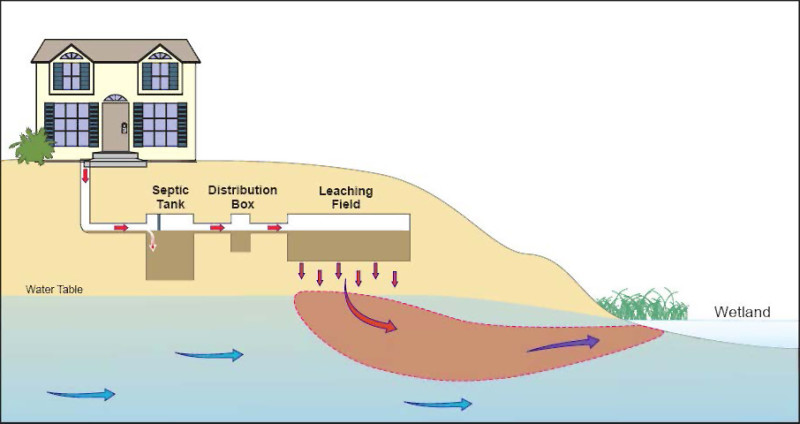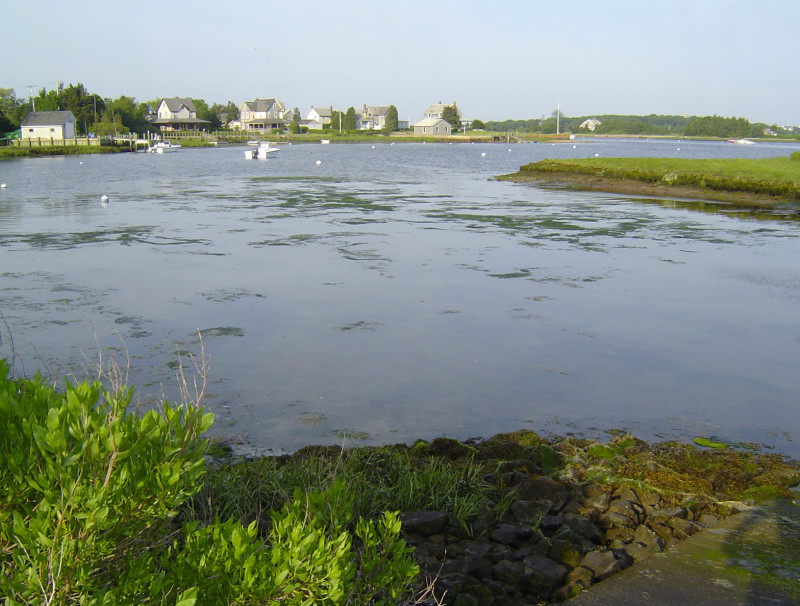Septic system upgrades can help clean up West Falmouth Harbor
But Cape Cod’s coastal waters are suffering from too much nitrogen, a type of pollution that comes from our homes, roads, and lawns. Nitrogen pollution seeps through the soil into groundwater, which flows out to the coves and harbors where we like to play.
Perhaps no place on Buzzards Bay is more aware of the nitrogen pollution problem than West Falmouth Harbor. With its calm, protected waters, West Falmouth Harbor is a haven for sailors and swimmers. But for the past 20 years, the harbor’s health has been in a slow, steady decline. Clumps of green algae cover the shoreline, and eelgrass – an underwater plant that serves as an indicator of water health – has vanished from many parts of the harbor.
The Coalition has been working to restore West Falmouth Harbor by tackling the harbor’s biggest source of nitrogen pollution: the local wastewater treatment plant. Working with the town of Falmouth and the Massachusetts Department of Environmental Protection, the Coalition helped set wastewater limits three years ago to reduce nitrogen pollution to the harbor.
Now West Falmouth Harbor is on the road to health – but it’s still going to take a few years before the water starts to improve.
This spring, local residents have an opportunity to speed up the harbor’s recovery, one that addresses another major source of nitrogen pollution in West Falmouth: septic systems. Through a new voluntary program coordinated in partnership by the Coalition and the town of Falmouth, some homeowners around the harbor will have support to upgrade their septic systems to new technology that will reduce nitrogen pollution and help clean up the harbor.
Why has West Falmouth Harbor’s health gotten so bad?
For the past 20 years, West Falmouth residents have watched their harbor decline due to nitrogen pollution. Bay health data collected through the Coalition’s Baywatchers program tells this story clearly. In the mid-1990s, the outer and middle portions of the harbor were in good health; today, they’re considered fair. Other parts of the harbor, including Snug Harbor, Oyster Pond, and Mashapaquit Creek, are in poor health.
The harbor’s health became so bad that in 2002, the U.S. EPA placed it on its list of “dirty waters” in need of a cleanup plan. Then, in 2008, the agency set a limit on the amount of nitrogen pollution that West Falmouth Harbor can handle. At the time, the harbor was receiving four times more nitrogen than the limit.
Nitrogen pollution is a big problem for coastal waterways like West Falmouth Harbor. It fuels the growth of algae, which makes the water cloudy and lines boats and beaches with green muck. Too much algae is also bad for fish and shellfish: If the water is cloudy, eelgrass can’t grow at the bottom. Without eelgrass, fish and shellfish have a hard time surviving.
A significant amount of nitrogen pollution to West Falmouth Harbor used to come from the town’s wastewater treatment plant, which discharges treated wastewater into the harbor. In 2005, Falmouth upgraded the wastewater treatment plant with new technology to reduce nitrogen. And in 2012, the state set a wastewater limit that capped the amount of nitrogen pollution that could flow into the harbor.
But to fully clean up the harbor, there’s another big source of nitrogen pollution – home septic systems – that still needs to be addressed.
How can septic system upgrades improve West Falmouth Harbor’s health?

Traditional septic systems don’t treat for nitrogen. Instead, nitrogen seeps into groundwater and eventually works its way into coves and harbors, where it can become pollution.
Across Buzzards Bay, septic systems are the largest source of nitrogen pollution to our coastal waterways. Even properly functioning septic systems – which most homes in rural and suburban areas use to treat waste – cause pollution problems. That’s because they don’t remove nitrogen from wastewater.
A single home septic system may not seem like an issue. But when you add up all the cesspools and septic systems around places like West Falmouth Harbor – where 100% of homes are on septic systems – they amount to a major source of pollution.
Septic systems can be upgraded to fix this problem. However, these upgrades can be expensive. It can cost upwards of $25,000 to replace a system, depending on the technology and site conditions. Fortunately, there’s a new source of funding available for homeowners who want to do their part to help the harbor.
I want to upgrade my septic system to help clean up the harbor. Can I take advantage of this funding?

Homes on old septic systems near the water can upgrade their systems to clean up the harbor’s health.
A new project coordinated in partnership by the Coalition and the town of Falmouth, with support from the Barnstable County Department of Public Health and the Environment and the West Falmouth Village Association, will help lower the cost for qualifying homeowners who want to upgrade their septic systems to help clean up the harbor and make a positive investment in the value of their homes.
The project is simple: Twenty local residents will be offered a $10,000 subsidy to upgrade their septic system to a system that reduces nitrogen pollution to West Falmouth Harbor. The Coalition will prioritize homes based on how close they are to the water, the age of their septic systems, and how much water they use. It’s a voluntary program, so only homeowners who want to upgrade their systems need to get involved.
Qualifying homeowners will be able to upgrade to one of two systems: A nitrogen-reducing septic system, which can remove about two-thirds of the nitrogen from a traditional system or cesspool, or an eco-toilet, which can also reduce nitrogen if used and managed properly.
The funding for this project comes from an EPA grant that Falmouth received last fall. The Southeast New England Coastal Watershed Restoration Program identified West Falmouth Harbor as one of five places around Buzzards Bay where collaborative, innovative local projects would protect clean water.
Homeowners around West Falmouth Harbor have a chance to make a real difference to protect clean water in their community. Working together, we can clean up the harbor so everybody can enjoy it, today and in the future.
To learn more and find out if you qualify to take part in this project, contact Korrin Petersen at the Coalition.